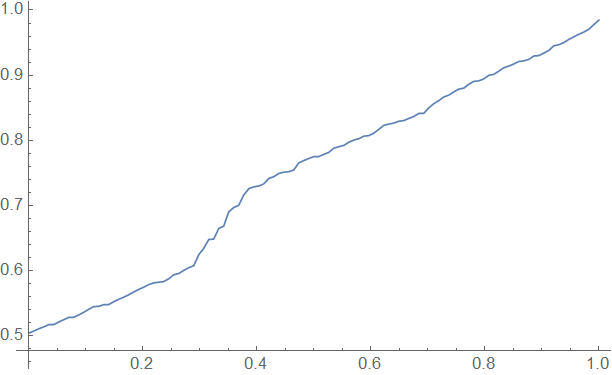Let's assume $x\in[0,1]$, and restrict all functions of $x$ that we consider to this domain. Consider a sequence $\mathcal S_n$ of sets of functions, where $n^{\text{th}}$ element is the set of all functions constructed from $n$ instances of the variable $x$ using exponentiation and parentheses. For example, $$\small \color{gray}{\mathcal S_1=}\left\{x\right\}\color{gray}{,\quad\mathcal S_2=}\left\{x^x\right\}\color{gray}{,\quad\mathcal S_3=}\left\{x^{x^x},\left(x^x\right)^x\right\}\color{gray}{,\quad\mathcal S_4=}\left\{x^{x^{x^x}},x^{\left(x^x\right)^x},\left(x^x\right)^{x^x},\left(\left(x^x\right)^x\right)^x\right\}\color{gray}{,}\\\small\color{gray}{\mathcal S_5=}\left\{x^{x^{x^{x^x}}},x^{x^{\left(x^x\right)^x}},x^{\left(x^x\right)^{x^x}},x^{\left(\left(x^x\right)^x\right)^x},\left(x^x\right)^{x^{x^x}},\left(x^x\right)^{\left(x^x\right)^x},\left(x^{x^x}\right)^{x^x},\left(\left(x^x\right)^x\right)^{x^x},\left(\left(\left(x^x\right)^x\right)^x\right)^x\right\}\color{gray}{,\,\text{etc.}}$$ Note that different parenthesizations can still result in functions that are identical on $[0,1]$ — we consider them as the same function (it appears in the set only once). The cardinality of elements $\left|\mathcal S_n\right|$ is counted by the $\small\text{OEIS}$ sequence $A000081$, which has been studied pretty well.
We assume that the value of a function at $x=0$ is the right limit of the corresponding expression for $x\to0^+$ (the limit can be either $0$ or $1$, the numbers of each outcome are counted by the $\small\text{OEIS}$ sequences $A222379$, $A222380$). This is equivalent to assuming $0^0=1$.
For each set $\mathcal S_n$ I integrated each function in it on $[0,1]$, sorted the list of results by magnitude and plotted them (indexes of the list were rescaled to fit on $[0,1]$, and discrete points connected by a polygonal chain). It appears that as $n$ grows, the graph starts looking "smoother" and converges to a certain curve. For example, for $n=8$ the graph looks like this:
And for $n=15$ it looks like this:
Can we (dis-)prove that the sequence of graphs indeed converges everywhere on $[0,1]$? If so, is the limiting curve continuous? Is it smooth?


